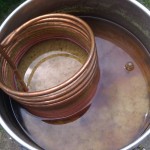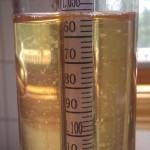On Sunday morning, I got up and brewed. The style for today was a German Pilsner.
As you can see on the aforehyperlinked recipe, the grain bill was simple. There were no specialty malts to speak of, just a bunch of pilsner malt. I opted for the floor malted version of Weyermann’s pilsner malt for something different.
My mash was low and slow. I got the mash temperature to 147° F and let the mash do its thing for 90 minutes, just to be extra sure I got a full conversion.
The boil was long too. It went on for 90 minutes to reduce the chances of DMS in the final beer. I made sure I had enough wort to accommodate the 30 minutes of additional evaporation time to get 5.5 gallons in my fermentor.
A few things I did differently for this beer.
- I used distilled water for half of the total amount of water I needed for the brew
- I added some gypsum to the water I used for the mash and some to the boil. It wasn’t that much, it was 4.5 grams in total.
- These things were done based on the water report we got back from Ward Labs and using water chemistry calculators to get it into the range for suitable water for a German pilsner.
- I remembered to use a Whirlfloc tablet to help with clarification. I didn’t use it for the Bohemian pilsner I brewed last year and I was unhappy with the clarity of thatbeer.
Since it was hot day, I wasn’t going to be able to chill the beer to the temperature I wanted, which was 44° F. I got it down to just under 70° F, transferred it to my cleaned and sanitized carboy, and put it into my fridge that was temperature controlled to the temp I wanted. Eighteen hours later, the wort’s temperate was where I wanted it to be so I aerated and pitched my yeast starters after decanting a good amount of the starter beer. I am excited to see what activity is when I get home tonight.
Here are some photos showing the cold break and the starting gravity reading that is just above where I wanted it to be.



Leave a Reply